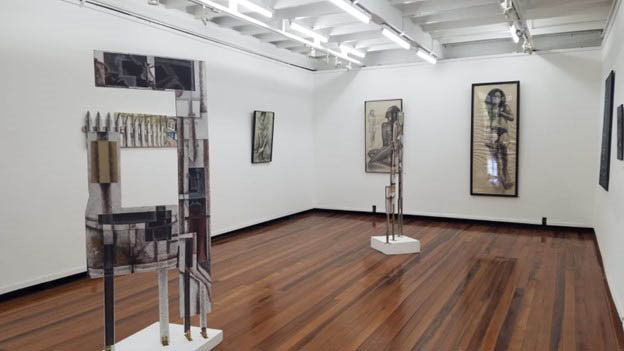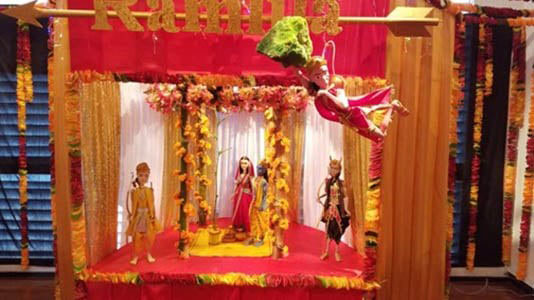
Most outstanding among these was the “exhibition in honour of the 60th Anniversary of the University of Guyana” titled Musings, Guyanese Folktales, & Figures of the Ramlila presented by the Division of Creative Arts within the Department of Language and Cultural Studies in the Faculty of Education and Humanities. This was mounted on October 16 -28 in the National Gallery of Art at Castellani House.
As we have previously observed, the University of Guyana has had an extremely valuable history of close relations with the fine arts dating back to the 1970s and the time when it first occupied buildings on the Turkeyen Campus (1969 – 1970). These include notable highlights such as the Rainforest Tapestry by the legendary Marjorie Broodhagen, the imposing sculpture “Royal Slaves” by Arthur Goodland and the first academic programme by Stanley Greaves who founded the Division of Creative Arts in 1975.

This anniversary exhibition will rate as perhaps the grandest and most impressive student exhibition since these were introduced as part of the new degree programme by Prof Doris Rogers in the 1990s. Since then exhibitions by graduating students have become an annual affair, but this one in October, 2023 was exceptional. It showed a very high quality of art, artists who have found or are obviously on the way to establishing identity and artistic statements. It was colourful, enriched by variety, profound expressions of theme and image, well befitting a university engaged in the study of art. The only blemish came from the exhibition’s co-existence with other events taking place at the same time. There was a very important film festival at the same venue which opened before the close of the exhibition – the disruptive outcome was that parts of the exhibition had to be dismantled to accommodate the showing of films. It was surprising that this was allowed to happen, the elaborate exhibition spending its last few days reduced and in tatters.
Musings, Guyanese Folktales, & Figures of the Ramlila was a show of paintings with a few pieces of sculpture/mixed media and drawings by students, staff and past students of the University of Guyana. It included the final year work of two graduating students – Vishnu Mahadeo and Daniel Diaram, lecturers Elodie Cage-Smith and Philbert Gajadhar, and a mixture of current students and alumni Ohene Koama, Douglas McKenzie, Keisha Pilgrim, Oliver Smith, Aubrey Alves, Tahirih Gerrard, Rouchelle Stephens, and Lisa Williams Josiah.
The two graduands, Mahadeo and Diaram, stood out. Mahadeo studied texts of the Hindu religion – The Ramayana, depicting the epic of Lord Ram (Rama) in a dominating representation of a presentation of the Ramlila, which is a dramatic folk performance tradition dramatising Hindu religious scriptures. He makes use of techniques in sculpture developed by lecturer Winslow Craig in an extraordinary creation of “Five Figures of the Ramlila” in a transformation of faith into art. Diaram also draws on the folk in his excursion into mythology, depicting versions of such supernatural folklore figures as Ole Higue, Moongazer and Kanaima – a mixture of realism and grotesque symbolism in “Folklores of Guyana Reimagined”.
Gajadhar and Cage-Smith are artists deeply engaged in research to inform inspiring imaginative conceptions. It is from this continuing work that they both drew in this exhibition. Cage-Smith, originally from the French Caribbean, is one of the seriously significant rising talents in Guyanese art who is preoccupied with history, African slavery and the Middle Passage in post-colonial paintings, producing images in profoundly symbolist work. She showed this in the exhibition. Gajadhar’s selections were from his ongoing series of work that he describes as inspired by Einstein’s Theory of Relati-vity. In work sometimes slightly reminiscent of cubism, he attempts to visualise movement in kathak dance and other subjects, drawing on Indian symbols as well, in such exhibits as “Jyoti (Divine Light) 2022, and “Vidya (Knowledge) 2022”.
Koama’s “Beyond the Fence 2020” revealed the fascinating strides taken by this artist in work produced by charcoal conte crayons and coloured pencils which give an interesting edge beyond the ordinary to his scenic depictions. Feminism in art, reflective of “the female gaze” stood out in the works of Gerrard, Stephens and Smith, each in their different forms, while Williams-Josiah manages to tell tales beyond the realism of “Parika Speedboat Stelling”.
Details of this exhibition were documented in an impressively informative catalogue, produced by Alim Hosein and Akima McPherson who were instrumental in the curation and administration of the show. The “Exhibition Overview” in the catalogue is a substantive critical piece worth reprinting in full. The following is extracted from it.
“Musings, Guyanese Folktales and Figures of the Ramlila presents the final year projects of two prospective graduates from the University of Guyana BA in Fine Art programme, alongside artwork done by their juniors, recent alumni, and two lecturers in the Division of Creative Arts. This collection of approximately 40 works ranges in approaches to artmaking and thematic concerns, although, as is customary for Guyana, paintings predominate. The variety of themes is reflective of the individual intellectual learning of the artists.
“In works by many of the artists, there is an overwhelming concern for the female body. For instance, Smith, in his “Guarded Reflections” series is motivated by the pained female body; his work is grounded in a harsh reality of Guyana and informed by interviews with victim-survivors of gendered violence. Mean-while, in Gerrard’s and Stephens’ work a strong raced and gendered preoccupation is evident […] Gerrard also offers strong criticism for the persistent denigration of the black female body alongside imaging that elevates her status.
“The grandeur and mystery of the Guyana landscape is a perennial source of inspiration for Guyanese painters. However, it is not a dominant concern among the remaining artists. Instead, in the work of the two prospective graduates one is met, on the one hand, with an atypical preoccupation with mythology in Diaram […] and with an in-depth study of religious text in Mahadeo […] when the landscape is referred to, it is referred to with intimacy rather than with overwhelming expansiveness. “Parika Speed-boat Stelling” is thus unusual. […] This contemplative aspect is present in the work of Pilgrim, whose cubist lilies are coy in the painting of the same title while her “Red Hibiscus” invites us to imaginatively look beyond the petals into the mysteries of the foliage.
“Atypical musings abound. Douglas in his suite of three paintings contemplates the harmonising and unifying power of music, while Gajadhar contemplates the rhythmic movement of the kathak dancer with kites at flight. Unusual for Guyana is the unfolding visual debate with art that engages Koama in his three drawings becoming sculpture. This preoccupation is not with art’s potential to be a handmaiden to society by reflecting its ills for correction or in proposing more harmonious alternatives. Instead, the duo of forms engages us in debate that is grounded in the materiality of art. Koama’s ‘drawings-in-the-round’ are quietly disruptive, while Alves’ paintings are imaginative vistas of his mind that take us back in time and to different geographical locations. Although a typical preoccupation for Caribbean artists and related to the concerns of other artists in the show, Cage-Smith offers bejewelled and heavily textured musings on fretful events of the Caribbean past.”





